Risk Management in Hospitality Industry
VerifiedAdded on 2023/04/26
|15
|3706
|452
AI Summary
This article discusses the importance of risk management in the hospitality industry and the various risks faced by physical, non-physical, financial, and human assets. It also covers the venue risk analysis process and the risk ranking system. The article provides recommendations for managing risks and ensuring the continuity of business operations.
Contribute Materials
Your contribution can guide someone’s learning journey. Share your
documents today.
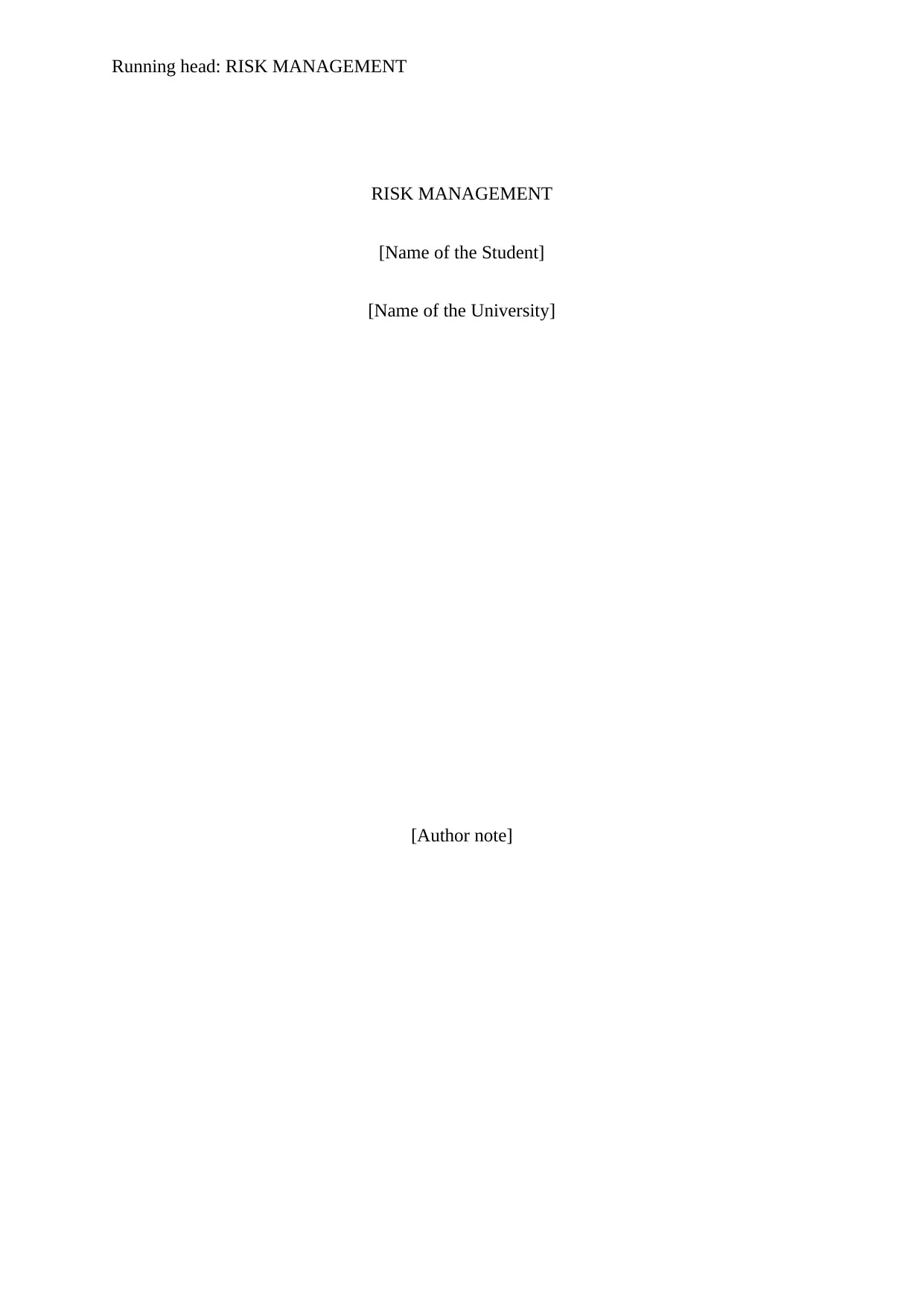
Running head: RISK MANAGEMENT
RISK MANAGEMENT
[Name of the Student]
[Name of the University]
[Author note]
RISK MANAGEMENT
[Name of the Student]
[Name of the University]
[Author note]
Secure Best Marks with AI Grader
Need help grading? Try our AI Grader for instant feedback on your assignments.
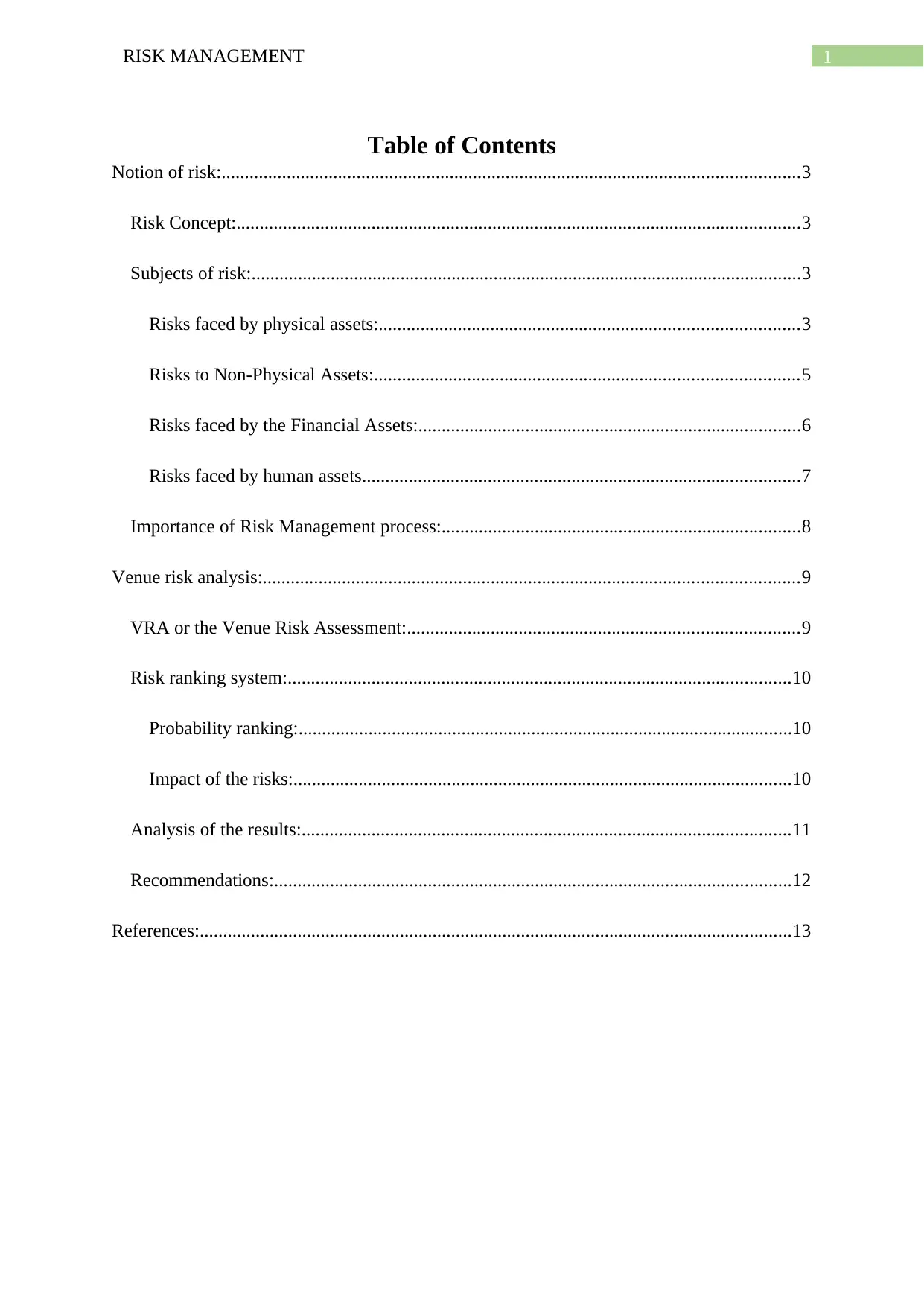
1RISK MANAGEMENT
Table of Contents
Notion of risk:............................................................................................................................3
Risk Concept:.........................................................................................................................3
Subjects of risk:......................................................................................................................3
Risks faced by physical assets:..........................................................................................3
Risks to Non-Physical Assets:...........................................................................................5
Risks faced by the Financial Assets:..................................................................................6
Risks faced by human assets..............................................................................................7
Importance of Risk Management process:.............................................................................8
Venue risk analysis:...................................................................................................................9
VRA or the Venue Risk Assessment:....................................................................................9
Risk ranking system:............................................................................................................10
Probability ranking:..........................................................................................................10
Impact of the risks:...........................................................................................................10
Analysis of the results:.........................................................................................................11
Recommendations:...............................................................................................................12
References:...............................................................................................................................13
Table of Contents
Notion of risk:............................................................................................................................3
Risk Concept:.........................................................................................................................3
Subjects of risk:......................................................................................................................3
Risks faced by physical assets:..........................................................................................3
Risks to Non-Physical Assets:...........................................................................................5
Risks faced by the Financial Assets:..................................................................................6
Risks faced by human assets..............................................................................................7
Importance of Risk Management process:.............................................................................8
Venue risk analysis:...................................................................................................................9
VRA or the Venue Risk Assessment:....................................................................................9
Risk ranking system:............................................................................................................10
Probability ranking:..........................................................................................................10
Impact of the risks:...........................................................................................................10
Analysis of the results:.........................................................................................................11
Recommendations:...............................................................................................................12
References:...............................................................................................................................13
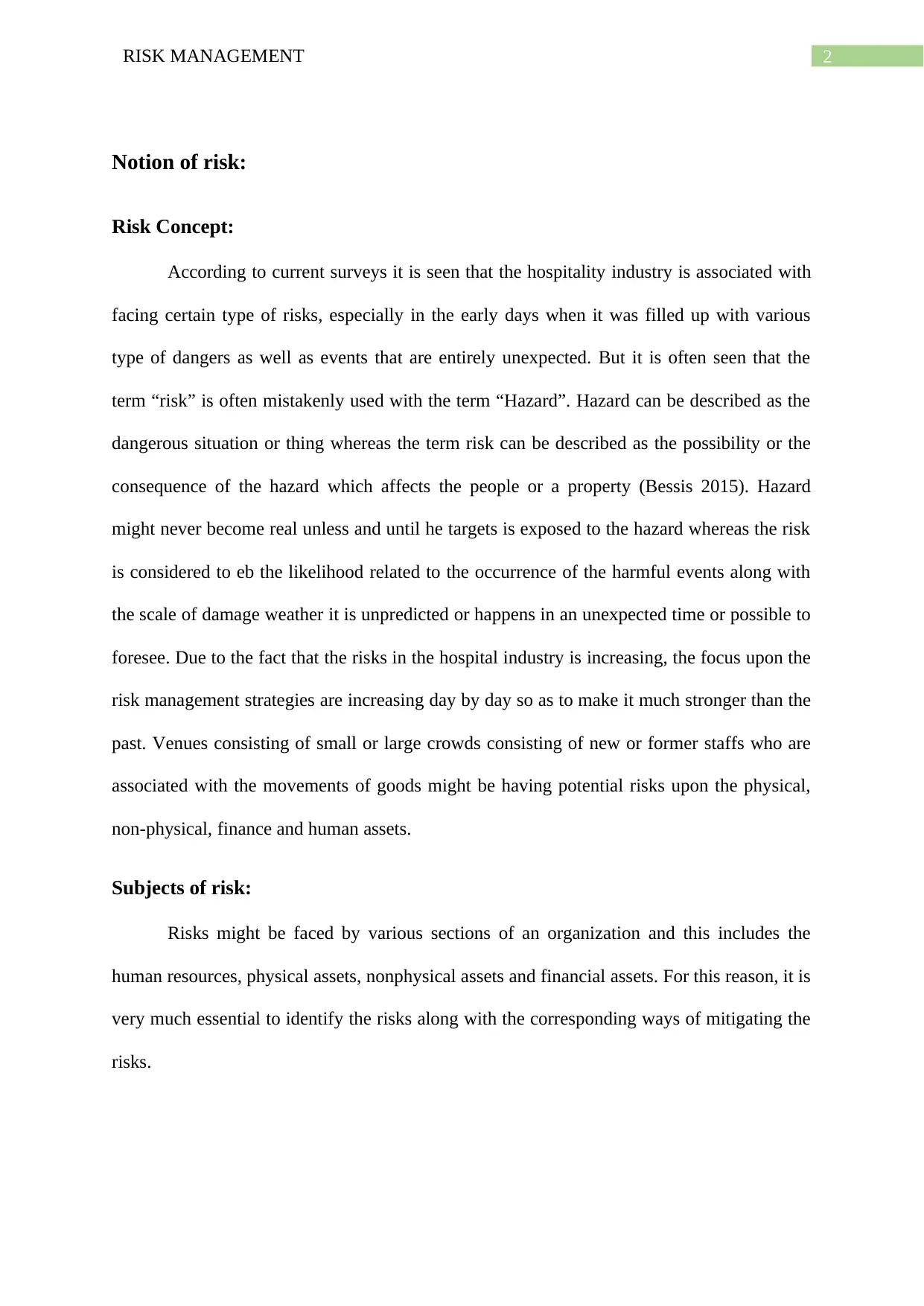
2RISK MANAGEMENT
Notion of risk:
Risk Concept:
According to current surveys it is seen that the hospitality industry is associated with
facing certain type of risks, especially in the early days when it was filled up with various
type of dangers as well as events that are entirely unexpected. But it is often seen that the
term “risk” is often mistakenly used with the term “Hazard”. Hazard can be described as the
dangerous situation or thing whereas the term risk can be described as the possibility or the
consequence of the hazard which affects the people or a property (Bessis 2015). Hazard
might never become real unless and until he targets is exposed to the hazard whereas the risk
is considered to eb the likelihood related to the occurrence of the harmful events along with
the scale of damage weather it is unpredicted or happens in an unexpected time or possible to
foresee. Due to the fact that the risks in the hospital industry is increasing, the focus upon the
risk management strategies are increasing day by day so as to make it much stronger than the
past. Venues consisting of small or large crowds consisting of new or former staffs who are
associated with the movements of goods might be having potential risks upon the physical,
non-physical, finance and human assets.
Subjects of risk:
Risks might be faced by various sections of an organization and this includes the
human resources, physical assets, nonphysical assets and financial assets. For this reason, it is
very much essential to identify the risks along with the corresponding ways of mitigating the
risks.
Notion of risk:
Risk Concept:
According to current surveys it is seen that the hospitality industry is associated with
facing certain type of risks, especially in the early days when it was filled up with various
type of dangers as well as events that are entirely unexpected. But it is often seen that the
term “risk” is often mistakenly used with the term “Hazard”. Hazard can be described as the
dangerous situation or thing whereas the term risk can be described as the possibility or the
consequence of the hazard which affects the people or a property (Bessis 2015). Hazard
might never become real unless and until he targets is exposed to the hazard whereas the risk
is considered to eb the likelihood related to the occurrence of the harmful events along with
the scale of damage weather it is unpredicted or happens in an unexpected time or possible to
foresee. Due to the fact that the risks in the hospital industry is increasing, the focus upon the
risk management strategies are increasing day by day so as to make it much stronger than the
past. Venues consisting of small or large crowds consisting of new or former staffs who are
associated with the movements of goods might be having potential risks upon the physical,
non-physical, finance and human assets.
Subjects of risk:
Risks might be faced by various sections of an organization and this includes the
human resources, physical assets, nonphysical assets and financial assets. For this reason, it is
very much essential to identify the risks along with the corresponding ways of mitigating the
risks.
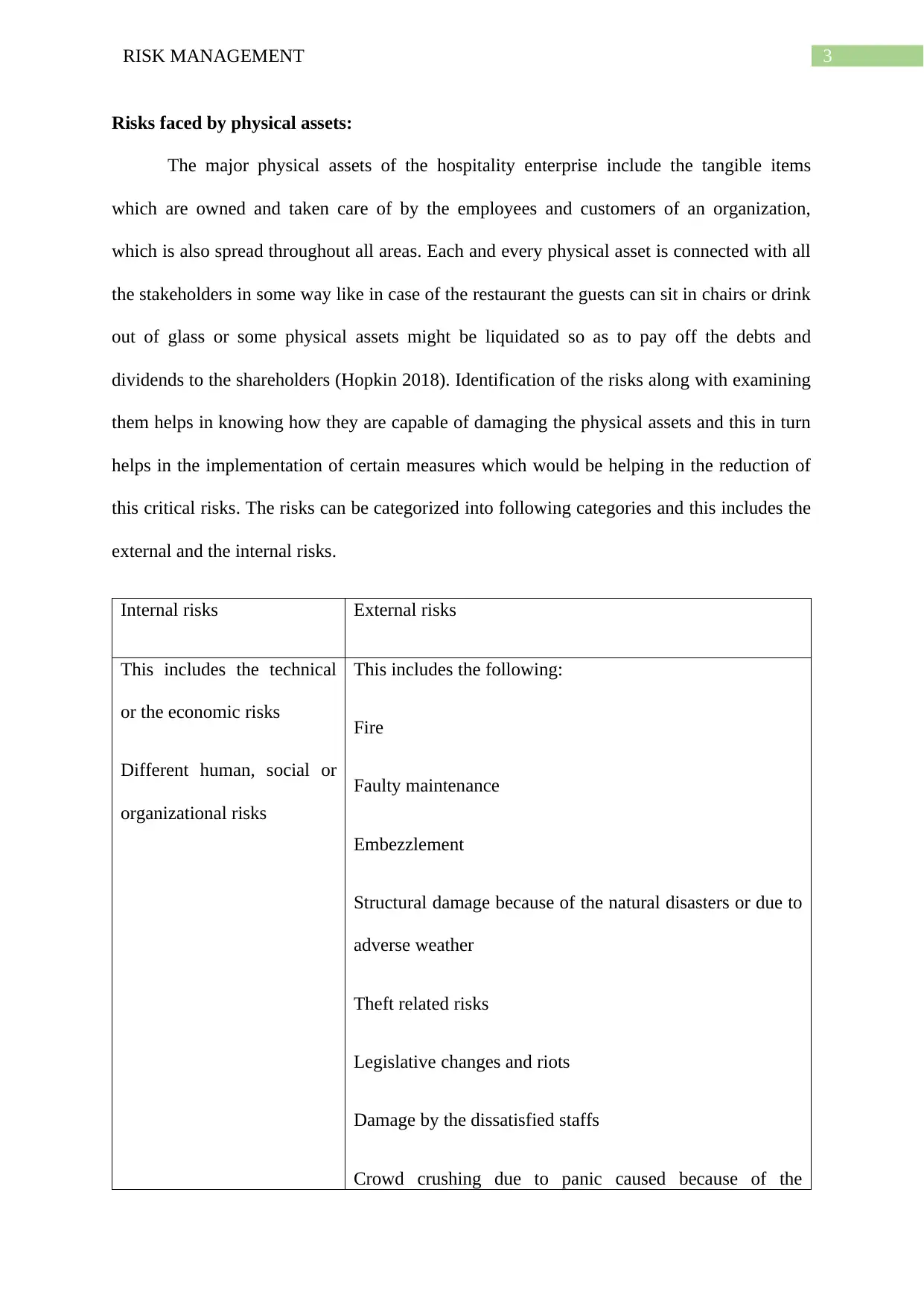
3RISK MANAGEMENT
Risks faced by physical assets:
The major physical assets of the hospitality enterprise include the tangible items
which are owned and taken care of by the employees and customers of an organization,
which is also spread throughout all areas. Each and every physical asset is connected with all
the stakeholders in some way like in case of the restaurant the guests can sit in chairs or drink
out of glass or some physical assets might be liquidated so as to pay off the debts and
dividends to the shareholders (Hopkin 2018). Identification of the risks along with examining
them helps in knowing how they are capable of damaging the physical assets and this in turn
helps in the implementation of certain measures which would be helping in the reduction of
this critical risks. The risks can be categorized into following categories and this includes the
external and the internal risks.
Internal risks External risks
This includes the technical
or the economic risks
Different human, social or
organizational risks
This includes the following:
Fire
Faulty maintenance
Embezzlement
Structural damage because of the natural disasters or due to
adverse weather
Theft related risks
Legislative changes and riots
Damage by the dissatisfied staffs
Crowd crushing due to panic caused because of the
Risks faced by physical assets:
The major physical assets of the hospitality enterprise include the tangible items
which are owned and taken care of by the employees and customers of an organization,
which is also spread throughout all areas. Each and every physical asset is connected with all
the stakeholders in some way like in case of the restaurant the guests can sit in chairs or drink
out of glass or some physical assets might be liquidated so as to pay off the debts and
dividends to the shareholders (Hopkin 2018). Identification of the risks along with examining
them helps in knowing how they are capable of damaging the physical assets and this in turn
helps in the implementation of certain measures which would be helping in the reduction of
this critical risks. The risks can be categorized into following categories and this includes the
external and the internal risks.
Internal risks External risks
This includes the technical
or the economic risks
Different human, social or
organizational risks
This includes the following:
Fire
Faulty maintenance
Embezzlement
Structural damage because of the natural disasters or due to
adverse weather
Theft related risks
Legislative changes and riots
Damage by the dissatisfied staffs
Crowd crushing due to panic caused because of the
Secure Best Marks with AI Grader
Need help grading? Try our AI Grader for instant feedback on your assignments.
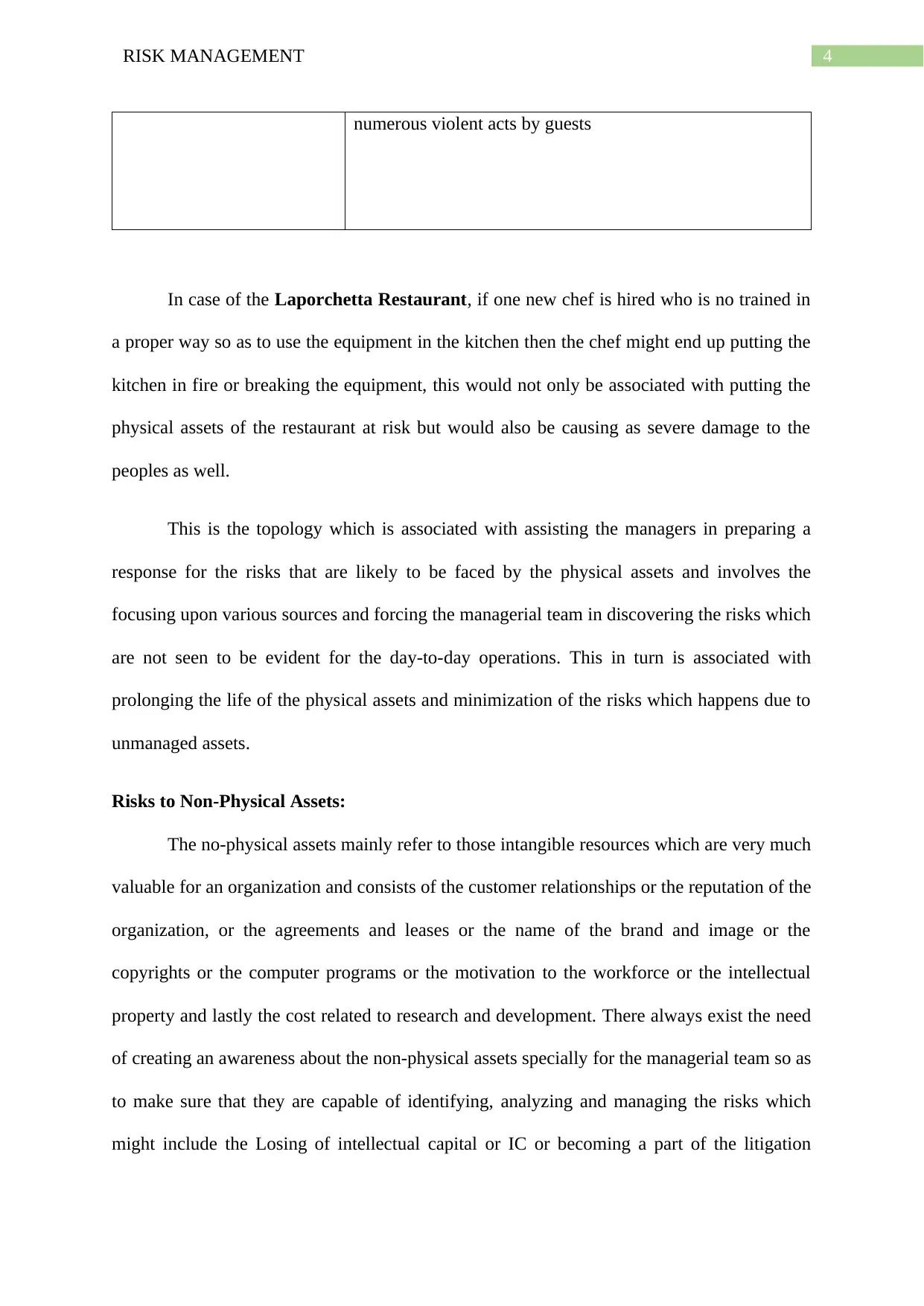
4RISK MANAGEMENT
numerous violent acts by guests
In case of the Laporchetta Restaurant, if one new chef is hired who is no trained in
a proper way so as to use the equipment in the kitchen then the chef might end up putting the
kitchen in fire or breaking the equipment, this would not only be associated with putting the
physical assets of the restaurant at risk but would also be causing as severe damage to the
peoples as well.
This is the topology which is associated with assisting the managers in preparing a
response for the risks that are likely to be faced by the physical assets and involves the
focusing upon various sources and forcing the managerial team in discovering the risks which
are not seen to be evident for the day-to-day operations. This in turn is associated with
prolonging the life of the physical assets and minimization of the risks which happens due to
unmanaged assets.
Risks to Non-Physical Assets:
The no-physical assets mainly refer to those intangible resources which are very much
valuable for an organization and consists of the customer relationships or the reputation of the
organization, or the agreements and leases or the name of the brand and image or the
copyrights or the computer programs or the motivation to the workforce or the intellectual
property and lastly the cost related to research and development. There always exist the need
of creating an awareness about the non-physical assets specially for the managerial team so as
to make sure that they are capable of identifying, analyzing and managing the risks which
might include the Losing of intellectual capital or IC or becoming a part of the litigation
numerous violent acts by guests
In case of the Laporchetta Restaurant, if one new chef is hired who is no trained in
a proper way so as to use the equipment in the kitchen then the chef might end up putting the
kitchen in fire or breaking the equipment, this would not only be associated with putting the
physical assets of the restaurant at risk but would also be causing as severe damage to the
peoples as well.
This is the topology which is associated with assisting the managers in preparing a
response for the risks that are likely to be faced by the physical assets and involves the
focusing upon various sources and forcing the managerial team in discovering the risks which
are not seen to be evident for the day-to-day operations. This in turn is associated with
prolonging the life of the physical assets and minimization of the risks which happens due to
unmanaged assets.
Risks to Non-Physical Assets:
The no-physical assets mainly refer to those intangible resources which are very much
valuable for an organization and consists of the customer relationships or the reputation of the
organization, or the agreements and leases or the name of the brand and image or the
copyrights or the computer programs or the motivation to the workforce or the intellectual
property and lastly the cost related to research and development. There always exist the need
of creating an awareness about the non-physical assets specially for the managerial team so as
to make sure that they are capable of identifying, analyzing and managing the risks which
might include the Losing of intellectual capital or IC or becoming a part of the litigation
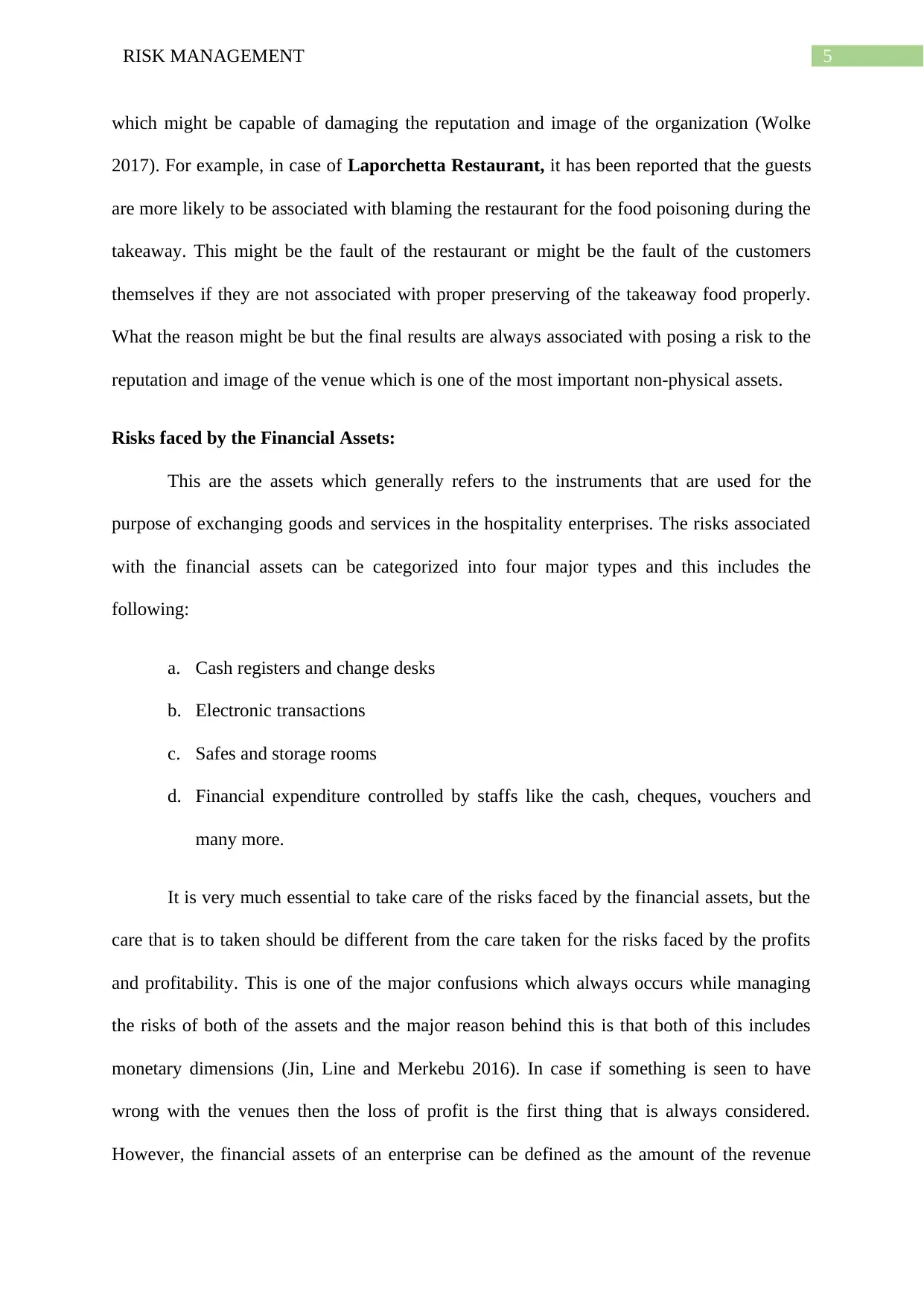
5RISK MANAGEMENT
which might be capable of damaging the reputation and image of the organization (Wolke
2017). For example, in case of Laporchetta Restaurant, it has been reported that the guests
are more likely to be associated with blaming the restaurant for the food poisoning during the
takeaway. This might be the fault of the restaurant or might be the fault of the customers
themselves if they are not associated with proper preserving of the takeaway food properly.
What the reason might be but the final results are always associated with posing a risk to the
reputation and image of the venue which is one of the most important non-physical assets.
Risks faced by the Financial Assets:
This are the assets which generally refers to the instruments that are used for the
purpose of exchanging goods and services in the hospitality enterprises. The risks associated
with the financial assets can be categorized into four major types and this includes the
following:
a. Cash registers and change desks
b. Electronic transactions
c. Safes and storage rooms
d. Financial expenditure controlled by staffs like the cash, cheques, vouchers and
many more.
It is very much essential to take care of the risks faced by the financial assets, but the
care that is to taken should be different from the care taken for the risks faced by the profits
and profitability. This is one of the major confusions which always occurs while managing
the risks of both of the assets and the major reason behind this is that both of this includes
monetary dimensions (Jin, Line and Merkebu 2016). In case if something is seen to have
wrong with the venues then the loss of profit is the first thing that is always considered.
However, the financial assets of an enterprise can be defined as the amount of the revenue
which might be capable of damaging the reputation and image of the organization (Wolke
2017). For example, in case of Laporchetta Restaurant, it has been reported that the guests
are more likely to be associated with blaming the restaurant for the food poisoning during the
takeaway. This might be the fault of the restaurant or might be the fault of the customers
themselves if they are not associated with proper preserving of the takeaway food properly.
What the reason might be but the final results are always associated with posing a risk to the
reputation and image of the venue which is one of the most important non-physical assets.
Risks faced by the Financial Assets:
This are the assets which generally refers to the instruments that are used for the
purpose of exchanging goods and services in the hospitality enterprises. The risks associated
with the financial assets can be categorized into four major types and this includes the
following:
a. Cash registers and change desks
b. Electronic transactions
c. Safes and storage rooms
d. Financial expenditure controlled by staffs like the cash, cheques, vouchers and
many more.
It is very much essential to take care of the risks faced by the financial assets, but the
care that is to taken should be different from the care taken for the risks faced by the profits
and profitability. This is one of the major confusions which always occurs while managing
the risks of both of the assets and the major reason behind this is that both of this includes
monetary dimensions (Jin, Line and Merkebu 2016). In case if something is seen to have
wrong with the venues then the loss of profit is the first thing that is always considered.
However, the financial assets of an enterprise can be defined as the amount of the revenue
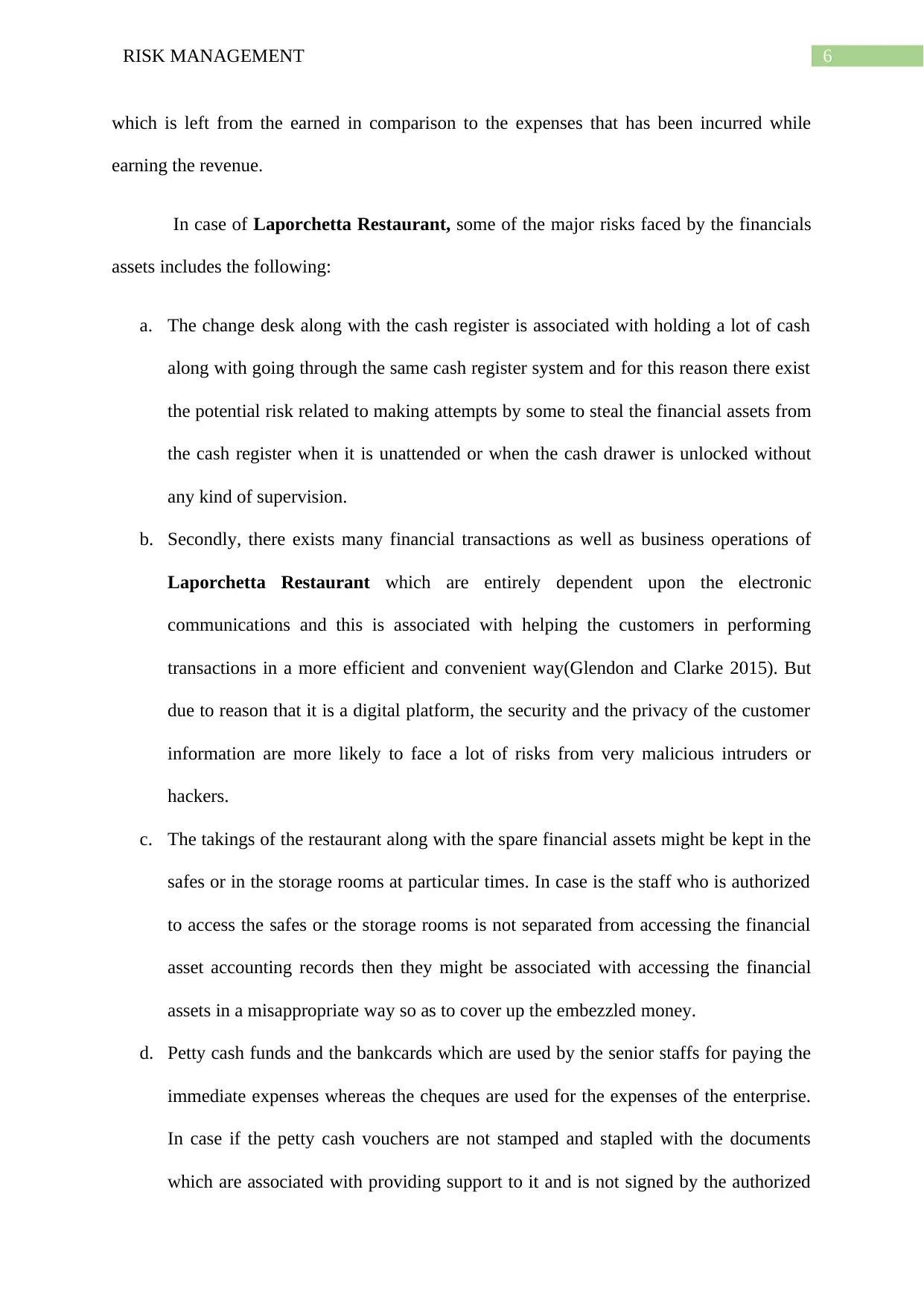
6RISK MANAGEMENT
which is left from the earned in comparison to the expenses that has been incurred while
earning the revenue.
In case of Laporchetta Restaurant, some of the major risks faced by the financials
assets includes the following:
a. The change desk along with the cash register is associated with holding a lot of cash
along with going through the same cash register system and for this reason there exist
the potential risk related to making attempts by some to steal the financial assets from
the cash register when it is unattended or when the cash drawer is unlocked without
any kind of supervision.
b. Secondly, there exists many financial transactions as well as business operations of
Laporchetta Restaurant which are entirely dependent upon the electronic
communications and this is associated with helping the customers in performing
transactions in a more efficient and convenient way(Glendon and Clarke 2015). But
due to reason that it is a digital platform, the security and the privacy of the customer
information are more likely to face a lot of risks from very malicious intruders or
hackers.
c. The takings of the restaurant along with the spare financial assets might be kept in the
safes or in the storage rooms at particular times. In case is the staff who is authorized
to access the safes or the storage rooms is not separated from accessing the financial
asset accounting records then they might be associated with accessing the financial
assets in a misappropriate way so as to cover up the embezzled money.
d. Petty cash funds and the bankcards which are used by the senior staffs for paying the
immediate expenses whereas the cheques are used for the expenses of the enterprise.
In case if the petty cash vouchers are not stamped and stapled with the documents
which are associated with providing support to it and is not signed by the authorized
which is left from the earned in comparison to the expenses that has been incurred while
earning the revenue.
In case of Laporchetta Restaurant, some of the major risks faced by the financials
assets includes the following:
a. The change desk along with the cash register is associated with holding a lot of cash
along with going through the same cash register system and for this reason there exist
the potential risk related to making attempts by some to steal the financial assets from
the cash register when it is unattended or when the cash drawer is unlocked without
any kind of supervision.
b. Secondly, there exists many financial transactions as well as business operations of
Laporchetta Restaurant which are entirely dependent upon the electronic
communications and this is associated with helping the customers in performing
transactions in a more efficient and convenient way(Glendon and Clarke 2015). But
due to reason that it is a digital platform, the security and the privacy of the customer
information are more likely to face a lot of risks from very malicious intruders or
hackers.
c. The takings of the restaurant along with the spare financial assets might be kept in the
safes or in the storage rooms at particular times. In case is the staff who is authorized
to access the safes or the storage rooms is not separated from accessing the financial
asset accounting records then they might be associated with accessing the financial
assets in a misappropriate way so as to cover up the embezzled money.
d. Petty cash funds and the bankcards which are used by the senior staffs for paying the
immediate expenses whereas the cheques are used for the expenses of the enterprise.
In case if the petty cash vouchers are not stamped and stapled with the documents
which are associated with providing support to it and is not signed by the authorized
Paraphrase This Document
Need a fresh take? Get an instant paraphrase of this document with our AI Paraphraser

7RISK MANAGEMENT
staffs then they can be used fraudulently (da CUNHA, de ROSSO and Stedefeldt
2016).
Risks faced by human assets
Along with the financial assets and the physical assets the human asset is another
most important asset for any kind of organization. Without any kind of staff’s members or
customers there would exist o business which could survive. For this reason, providing
protection to the customers as well as to the employees from various potential risks is very
important and certain actions needs to be taken necessarily so as to do this. The risks which
are faced by the human assets of the hospitality industry mainly happens to the people or are
caused by the peoples (Koh et al. 2018). The risks might be happening in various forms like
the staffs getting injured by tripping or due to carrying of the overweight boxes and
equipment or when the customer slips and falls due to wet floors. Contrarily the risks can also
be caused due to peoples. Besides this the inexperienced staffs might work without being
trained in a proper way about the safety procedures and can be considered to eb major risk for
example causing of fire due to appointment of new cook. This would not only be liable for
the compensation but would also be associated with facing the prospect of the business losses
and this is initially responsible for making the hospitality enterprises must be associated with
assessing and managing the risks which are involved in the human assets.
Importance of Risk Management process:
Risk is inevitable for each and every business. For this reason, it is crucial for the
hospitality enterprises so as to devise the strategies so as to manage the risks in an efficient
way and for the purpose of avoiding the unexpected events which are responsible for causing
interrupting the day-to-day business operations (Chance and Brooks 2015). This would be
helping in protecting the assets of the venue as well as the reputation by means of
staffs then they can be used fraudulently (da CUNHA, de ROSSO and Stedefeldt
2016).
Risks faced by human assets
Along with the financial assets and the physical assets the human asset is another
most important asset for any kind of organization. Without any kind of staff’s members or
customers there would exist o business which could survive. For this reason, providing
protection to the customers as well as to the employees from various potential risks is very
important and certain actions needs to be taken necessarily so as to do this. The risks which
are faced by the human assets of the hospitality industry mainly happens to the people or are
caused by the peoples (Koh et al. 2018). The risks might be happening in various forms like
the staffs getting injured by tripping or due to carrying of the overweight boxes and
equipment or when the customer slips and falls due to wet floors. Contrarily the risks can also
be caused due to peoples. Besides this the inexperienced staffs might work without being
trained in a proper way about the safety procedures and can be considered to eb major risk for
example causing of fire due to appointment of new cook. This would not only be liable for
the compensation but would also be associated with facing the prospect of the business losses
and this is initially responsible for making the hospitality enterprises must be associated with
assessing and managing the risks which are involved in the human assets.
Importance of Risk Management process:
Risk is inevitable for each and every business. For this reason, it is crucial for the
hospitality enterprises so as to devise the strategies so as to manage the risks in an efficient
way and for the purpose of avoiding the unexpected events which are responsible for causing
interrupting the day-to-day business operations (Chance and Brooks 2015). This would be
helping in protecting the assets of the venue as well as the reputation by means of
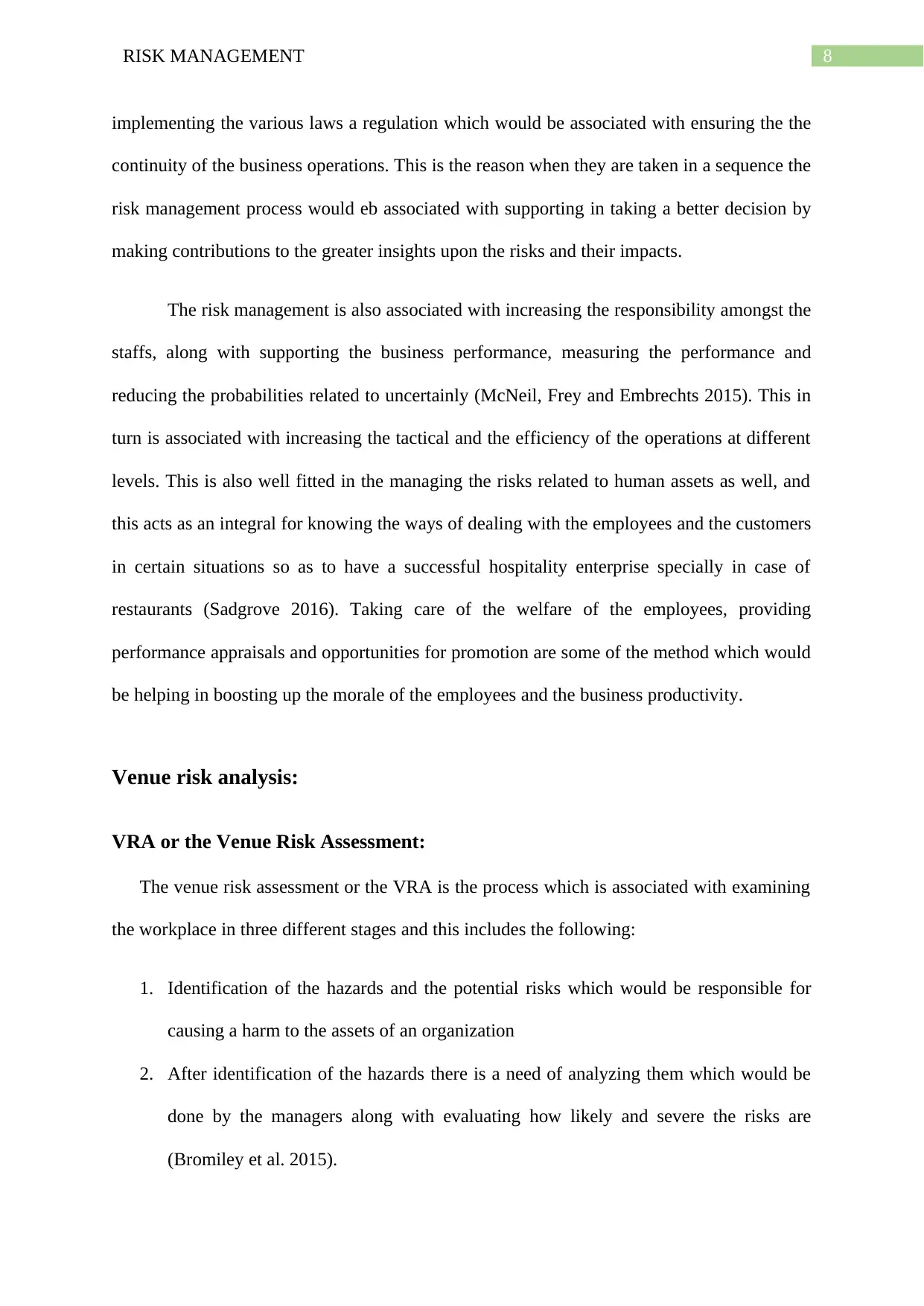
8RISK MANAGEMENT
implementing the various laws a regulation which would be associated with ensuring the the
continuity of the business operations. This is the reason when they are taken in a sequence the
risk management process would eb associated with supporting in taking a better decision by
making contributions to the greater insights upon the risks and their impacts.
The risk management is also associated with increasing the responsibility amongst the
staffs, along with supporting the business performance, measuring the performance and
reducing the probabilities related to uncertainly (McNeil, Frey and Embrechts 2015). This in
turn is associated with increasing the tactical and the efficiency of the operations at different
levels. This is also well fitted in the managing the risks related to human assets as well, and
this acts as an integral for knowing the ways of dealing with the employees and the customers
in certain situations so as to have a successful hospitality enterprise specially in case of
restaurants (Sadgrove 2016). Taking care of the welfare of the employees, providing
performance appraisals and opportunities for promotion are some of the method which would
be helping in boosting up the morale of the employees and the business productivity.
Venue risk analysis:
VRA or the Venue Risk Assessment:
The venue risk assessment or the VRA is the process which is associated with examining
the workplace in three different stages and this includes the following:
1. Identification of the hazards and the potential risks which would be responsible for
causing a harm to the assets of an organization
2. After identification of the hazards there is a need of analyzing them which would be
done by the managers along with evaluating how likely and severe the risks are
(Bromiley et al. 2015).
implementing the various laws a regulation which would be associated with ensuring the the
continuity of the business operations. This is the reason when they are taken in a sequence the
risk management process would eb associated with supporting in taking a better decision by
making contributions to the greater insights upon the risks and their impacts.
The risk management is also associated with increasing the responsibility amongst the
staffs, along with supporting the business performance, measuring the performance and
reducing the probabilities related to uncertainly (McNeil, Frey and Embrechts 2015). This in
turn is associated with increasing the tactical and the efficiency of the operations at different
levels. This is also well fitted in the managing the risks related to human assets as well, and
this acts as an integral for knowing the ways of dealing with the employees and the customers
in certain situations so as to have a successful hospitality enterprise specially in case of
restaurants (Sadgrove 2016). Taking care of the welfare of the employees, providing
performance appraisals and opportunities for promotion are some of the method which would
be helping in boosting up the morale of the employees and the business productivity.
Venue risk analysis:
VRA or the Venue Risk Assessment:
The venue risk assessment or the VRA is the process which is associated with examining
the workplace in three different stages and this includes the following:
1. Identification of the hazards and the potential risks which would be responsible for
causing a harm to the assets of an organization
2. After identification of the hazards there is a need of analyzing them which would be
done by the managers along with evaluating how likely and severe the risks are
(Bromiley et al. 2015).
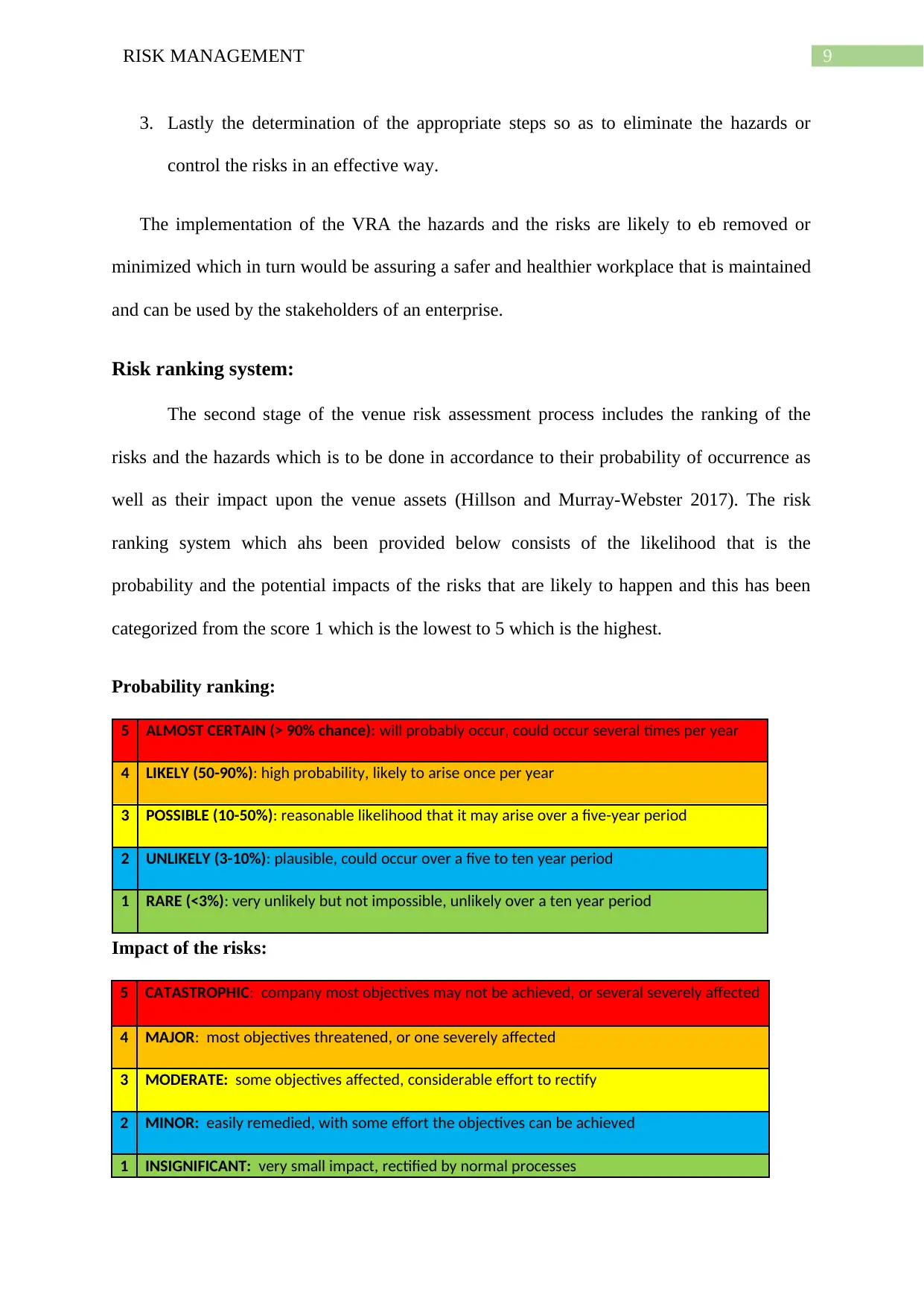
9RISK MANAGEMENT
3. Lastly the determination of the appropriate steps so as to eliminate the hazards or
control the risks in an effective way.
The implementation of the VRA the hazards and the risks are likely to eb removed or
minimized which in turn would be assuring a safer and healthier workplace that is maintained
and can be used by the stakeholders of an enterprise.
Risk ranking system:
The second stage of the venue risk assessment process includes the ranking of the
risks and the hazards which is to be done in accordance to their probability of occurrence as
well as their impact upon the venue assets (Hillson and Murray-Webster 2017). The risk
ranking system which ahs been provided below consists of the likelihood that is the
probability and the potential impacts of the risks that are likely to happen and this has been
categorized from the score 1 which is the lowest to 5 which is the highest.
Probability ranking:
5 ALMOST CERTAIN (> 90% chance): will probably occur, could occur several times per year
4 LIKELY (50-90%): high probability, likely to arise once per year
3 POSSIBLE (10-50%): reasonable likelihood that it may arise over a five-year period
2 UNLIKELY (3-10%): plausible, could occur over a five to ten year period
1 RARE (<3%): very unlikely but not impossible, unlikely over a ten year period
Impact of the risks:
5 CATASTROPHIC: company most objectives may not be achieved, or several severely affected
4 MAJOR: most objectives threatened, or one severely affected
3 MODERATE: some objectives affected, considerable effort to rectify
2 MINOR: easily remedied, with some effort the objectives can be achieved
1 INSIGNIFICANT: very small impact, rectified by normal processes
3. Lastly the determination of the appropriate steps so as to eliminate the hazards or
control the risks in an effective way.
The implementation of the VRA the hazards and the risks are likely to eb removed or
minimized which in turn would be assuring a safer and healthier workplace that is maintained
and can be used by the stakeholders of an enterprise.
Risk ranking system:
The second stage of the venue risk assessment process includes the ranking of the
risks and the hazards which is to be done in accordance to their probability of occurrence as
well as their impact upon the venue assets (Hillson and Murray-Webster 2017). The risk
ranking system which ahs been provided below consists of the likelihood that is the
probability and the potential impacts of the risks that are likely to happen and this has been
categorized from the score 1 which is the lowest to 5 which is the highest.
Probability ranking:
5 ALMOST CERTAIN (> 90% chance): will probably occur, could occur several times per year
4 LIKELY (50-90%): high probability, likely to arise once per year
3 POSSIBLE (10-50%): reasonable likelihood that it may arise over a five-year period
2 UNLIKELY (3-10%): plausible, could occur over a five to ten year period
1 RARE (<3%): very unlikely but not impossible, unlikely over a ten year period
Impact of the risks:
5 CATASTROPHIC: company most objectives may not be achieved, or several severely affected
4 MAJOR: most objectives threatened, or one severely affected
3 MODERATE: some objectives affected, considerable effort to rectify
2 MINOR: easily remedied, with some effort the objectives can be achieved
1 INSIGNIFICANT: very small impact, rectified by normal processes
Secure Best Marks with AI Grader
Need help grading? Try our AI Grader for instant feedback on your assignments.
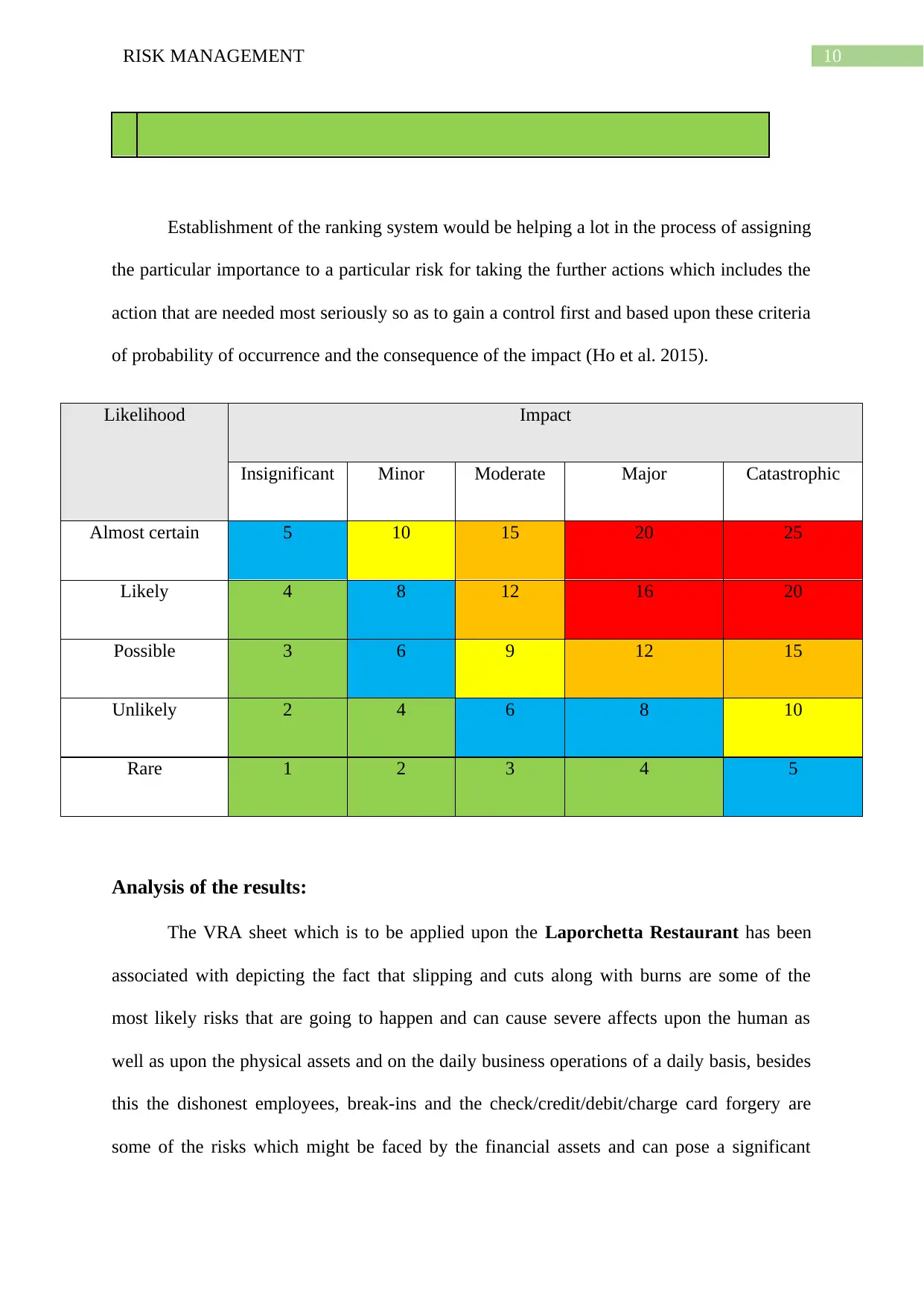
10RISK MANAGEMENT
Establishment of the ranking system would be helping a lot in the process of assigning
the particular importance to a particular risk for taking the further actions which includes the
action that are needed most seriously so as to gain a control first and based upon these criteria
of probability of occurrence and the consequence of the impact (Ho et al. 2015).
Likelihood Impact
Insignificant Minor Moderate Major Catastrophic
Almost certain 5 10 15 20 25
Likely 4 8 12 16 20
Possible 3 6 9 12 15
Unlikely 2 4 6 8 10
Rare 1 2 3 4 5
Analysis of the results:
The VRA sheet which is to be applied upon the Laporchetta Restaurant has been
associated with depicting the fact that slipping and cuts along with burns are some of the
most likely risks that are going to happen and can cause severe affects upon the human as
well as upon the physical assets and on the daily business operations of a daily basis, besides
this the dishonest employees, break-ins and the check/credit/debit/charge card forgery are
some of the risks which might be faced by the financial assets and can pose a significant
Establishment of the ranking system would be helping a lot in the process of assigning
the particular importance to a particular risk for taking the further actions which includes the
action that are needed most seriously so as to gain a control first and based upon these criteria
of probability of occurrence and the consequence of the impact (Ho et al. 2015).
Likelihood Impact
Insignificant Minor Moderate Major Catastrophic
Almost certain 5 10 15 20 25
Likely 4 8 12 16 20
Possible 3 6 9 12 15
Unlikely 2 4 6 8 10
Rare 1 2 3 4 5
Analysis of the results:
The VRA sheet which is to be applied upon the Laporchetta Restaurant has been
associated with depicting the fact that slipping and cuts along with burns are some of the
most likely risks that are going to happen and can cause severe affects upon the human as
well as upon the physical assets and on the daily business operations of a daily basis, besides
this the dishonest employees, break-ins and the check/credit/debit/charge card forgery are
some of the risks which might be faced by the financial assets and can pose a significant
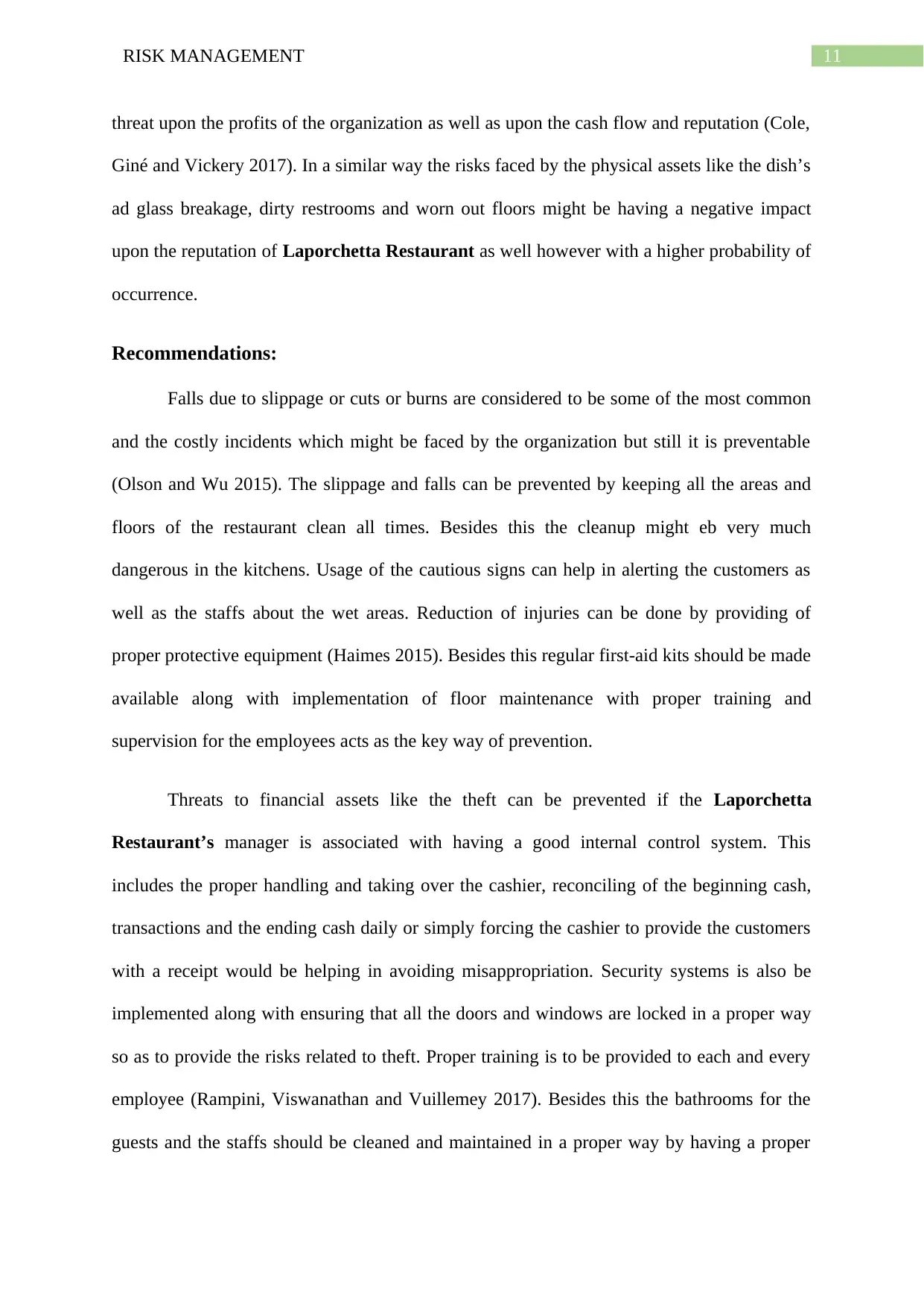
11RISK MANAGEMENT
threat upon the profits of the organization as well as upon the cash flow and reputation (Cole,
Giné and Vickery 2017). In a similar way the risks faced by the physical assets like the dish’s
ad glass breakage, dirty restrooms and worn out floors might be having a negative impact
upon the reputation of Laporchetta Restaurant as well however with a higher probability of
occurrence.
Recommendations:
Falls due to slippage or cuts or burns are considered to be some of the most common
and the costly incidents which might be faced by the organization but still it is preventable
(Olson and Wu 2015). The slippage and falls can be prevented by keeping all the areas and
floors of the restaurant clean all times. Besides this the cleanup might eb very much
dangerous in the kitchens. Usage of the cautious signs can help in alerting the customers as
well as the staffs about the wet areas. Reduction of injuries can be done by providing of
proper protective equipment (Haimes 2015). Besides this regular first-aid kits should be made
available along with implementation of floor maintenance with proper training and
supervision for the employees acts as the key way of prevention.
Threats to financial assets like the theft can be prevented if the Laporchetta
Restaurant’s manager is associated with having a good internal control system. This
includes the proper handling and taking over the cashier, reconciling of the beginning cash,
transactions and the ending cash daily or simply forcing the cashier to provide the customers
with a receipt would be helping in avoiding misappropriation. Security systems is also be
implemented along with ensuring that all the doors and windows are locked in a proper way
so as to provide the risks related to theft. Proper training is to be provided to each and every
employee (Rampini, Viswanathan and Vuillemey 2017). Besides this the bathrooms for the
guests and the staffs should be cleaned and maintained in a proper way by having a proper
threat upon the profits of the organization as well as upon the cash flow and reputation (Cole,
Giné and Vickery 2017). In a similar way the risks faced by the physical assets like the dish’s
ad glass breakage, dirty restrooms and worn out floors might be having a negative impact
upon the reputation of Laporchetta Restaurant as well however with a higher probability of
occurrence.
Recommendations:
Falls due to slippage or cuts or burns are considered to be some of the most common
and the costly incidents which might be faced by the organization but still it is preventable
(Olson and Wu 2015). The slippage and falls can be prevented by keeping all the areas and
floors of the restaurant clean all times. Besides this the cleanup might eb very much
dangerous in the kitchens. Usage of the cautious signs can help in alerting the customers as
well as the staffs about the wet areas. Reduction of injuries can be done by providing of
proper protective equipment (Haimes 2015). Besides this regular first-aid kits should be made
available along with implementation of floor maintenance with proper training and
supervision for the employees acts as the key way of prevention.
Threats to financial assets like the theft can be prevented if the Laporchetta
Restaurant’s manager is associated with having a good internal control system. This
includes the proper handling and taking over the cashier, reconciling of the beginning cash,
transactions and the ending cash daily or simply forcing the cashier to provide the customers
with a receipt would be helping in avoiding misappropriation. Security systems is also be
implemented along with ensuring that all the doors and windows are locked in a proper way
so as to provide the risks related to theft. Proper training is to be provided to each and every
employee (Rampini, Viswanathan and Vuillemey 2017). Besides this the bathrooms for the
guests and the staffs should be cleaned and maintained in a proper way by having a proper
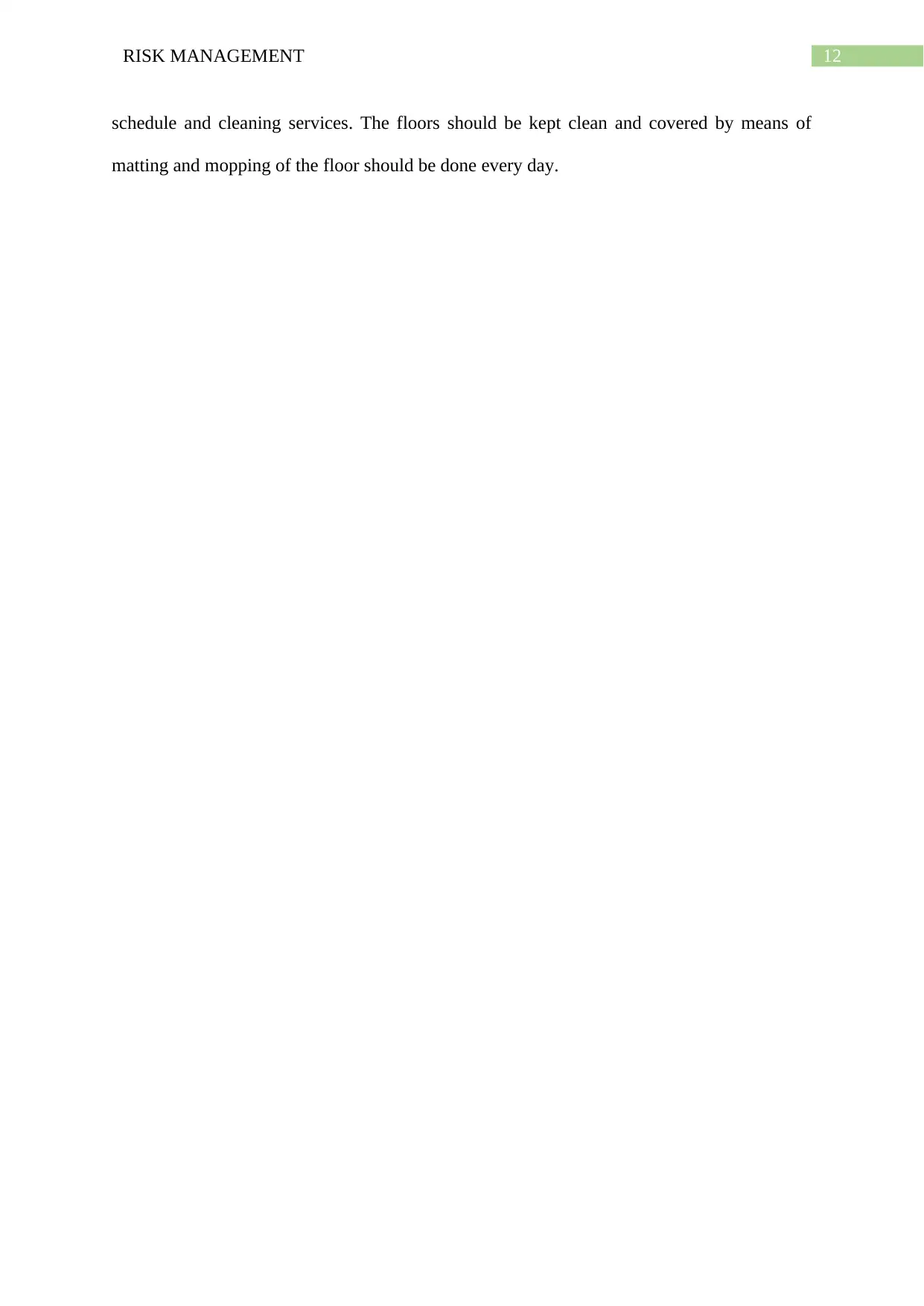
12RISK MANAGEMENT
schedule and cleaning services. The floors should be kept clean and covered by means of
matting and mopping of the floor should be done every day.
schedule and cleaning services. The floors should be kept clean and covered by means of
matting and mopping of the floor should be done every day.
Paraphrase This Document
Need a fresh take? Get an instant paraphrase of this document with our AI Paraphraser
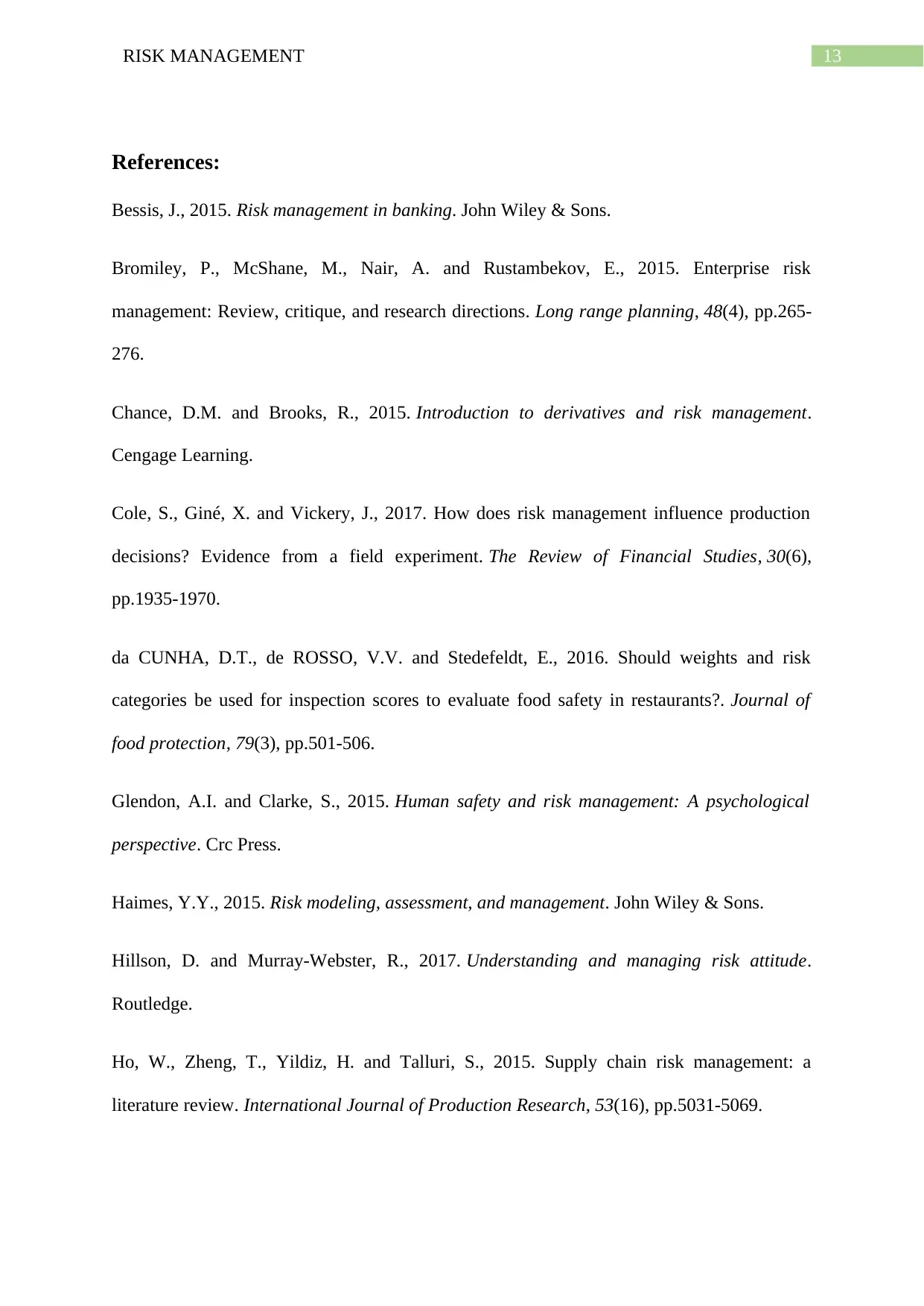
13RISK MANAGEMENT
References:
Bessis, J., 2015. Risk management in banking. John Wiley & Sons.
Bromiley, P., McShane, M., Nair, A. and Rustambekov, E., 2015. Enterprise risk
management: Review, critique, and research directions. Long range planning, 48(4), pp.265-
276.
Chance, D.M. and Brooks, R., 2015. Introduction to derivatives and risk management.
Cengage Learning.
Cole, S., Giné, X. and Vickery, J., 2017. How does risk management influence production
decisions? Evidence from a field experiment. The Review of Financial Studies, 30(6),
pp.1935-1970.
da CUNHA, D.T., de ROSSO, V.V. and Stedefeldt, E., 2016. Should weights and risk
categories be used for inspection scores to evaluate food safety in restaurants?. Journal of
food protection, 79(3), pp.501-506.
Glendon, A.I. and Clarke, S., 2015. Human safety and risk management: A psychological
perspective. Crc Press.
Haimes, Y.Y., 2015. Risk modeling, assessment, and management. John Wiley & Sons.
Hillson, D. and Murray-Webster, R., 2017. Understanding and managing risk attitude.
Routledge.
Ho, W., Zheng, T., Yildiz, H. and Talluri, S., 2015. Supply chain risk management: a
literature review. International Journal of Production Research, 53(16), pp.5031-5069.
References:
Bessis, J., 2015. Risk management in banking. John Wiley & Sons.
Bromiley, P., McShane, M., Nair, A. and Rustambekov, E., 2015. Enterprise risk
management: Review, critique, and research directions. Long range planning, 48(4), pp.265-
276.
Chance, D.M. and Brooks, R., 2015. Introduction to derivatives and risk management.
Cengage Learning.
Cole, S., Giné, X. and Vickery, J., 2017. How does risk management influence production
decisions? Evidence from a field experiment. The Review of Financial Studies, 30(6),
pp.1935-1970.
da CUNHA, D.T., de ROSSO, V.V. and Stedefeldt, E., 2016. Should weights and risk
categories be used for inspection scores to evaluate food safety in restaurants?. Journal of
food protection, 79(3), pp.501-506.
Glendon, A.I. and Clarke, S., 2015. Human safety and risk management: A psychological
perspective. Crc Press.
Haimes, Y.Y., 2015. Risk modeling, assessment, and management. John Wiley & Sons.
Hillson, D. and Murray-Webster, R., 2017. Understanding and managing risk attitude.
Routledge.
Ho, W., Zheng, T., Yildiz, H. and Talluri, S., 2015. Supply chain risk management: a
literature review. International Journal of Production Research, 53(16), pp.5031-5069.
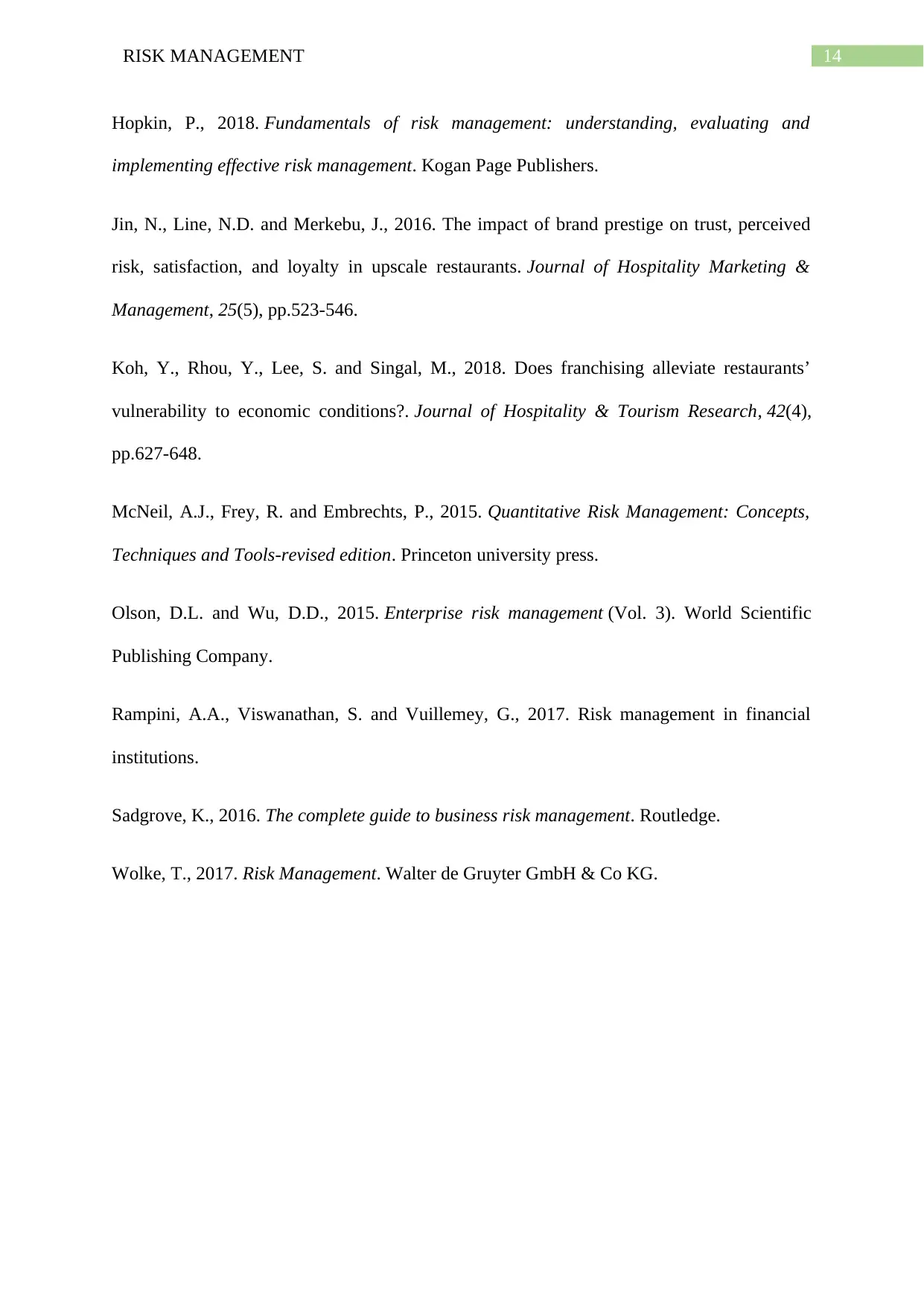
14RISK MANAGEMENT
Hopkin, P., 2018. Fundamentals of risk management: understanding, evaluating and
implementing effective risk management. Kogan Page Publishers.
Jin, N., Line, N.D. and Merkebu, J., 2016. The impact of brand prestige on trust, perceived
risk, satisfaction, and loyalty in upscale restaurants. Journal of Hospitality Marketing &
Management, 25(5), pp.523-546.
Koh, Y., Rhou, Y., Lee, S. and Singal, M., 2018. Does franchising alleviate restaurants’
vulnerability to economic conditions?. Journal of Hospitality & Tourism Research, 42(4),
pp.627-648.
McNeil, A.J., Frey, R. and Embrechts, P., 2015. Quantitative Risk Management: Concepts,
Techniques and Tools-revised edition. Princeton university press.
Olson, D.L. and Wu, D.D., 2015. Enterprise risk management (Vol. 3). World Scientific
Publishing Company.
Rampini, A.A., Viswanathan, S. and Vuillemey, G., 2017. Risk management in financial
institutions.
Sadgrove, K., 2016. The complete guide to business risk management. Routledge.
Wolke, T., 2017. Risk Management. Walter de Gruyter GmbH & Co KG.
Hopkin, P., 2018. Fundamentals of risk management: understanding, evaluating and
implementing effective risk management. Kogan Page Publishers.
Jin, N., Line, N.D. and Merkebu, J., 2016. The impact of brand prestige on trust, perceived
risk, satisfaction, and loyalty in upscale restaurants. Journal of Hospitality Marketing &
Management, 25(5), pp.523-546.
Koh, Y., Rhou, Y., Lee, S. and Singal, M., 2018. Does franchising alleviate restaurants’
vulnerability to economic conditions?. Journal of Hospitality & Tourism Research, 42(4),
pp.627-648.
McNeil, A.J., Frey, R. and Embrechts, P., 2015. Quantitative Risk Management: Concepts,
Techniques and Tools-revised edition. Princeton university press.
Olson, D.L. and Wu, D.D., 2015. Enterprise risk management (Vol. 3). World Scientific
Publishing Company.
Rampini, A.A., Viswanathan, S. and Vuillemey, G., 2017. Risk management in financial
institutions.
Sadgrove, K., 2016. The complete guide to business risk management. Routledge.
Wolke, T., 2017. Risk Management. Walter de Gruyter GmbH & Co KG.
1 out of 15
Related Documents
Your All-in-One AI-Powered Toolkit for Academic Success.
+13062052269
info@desklib.com
Available 24*7 on WhatsApp / Email
![[object Object]](/_next/static/media/star-bottom.7253800d.svg)
Unlock your academic potential
© 2024 | Zucol Services PVT LTD | All rights reserved.




